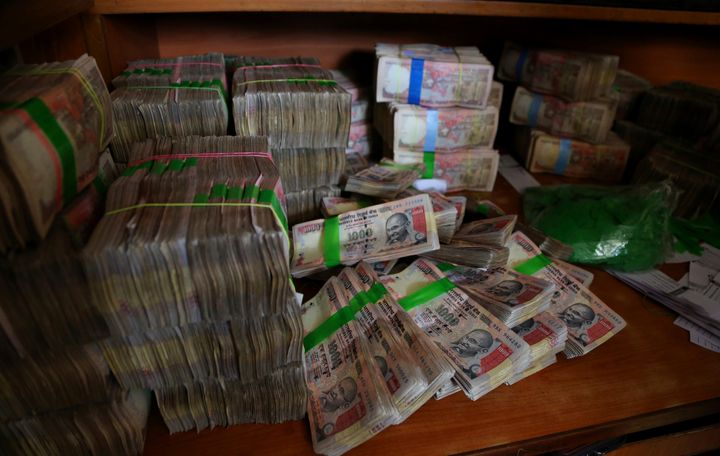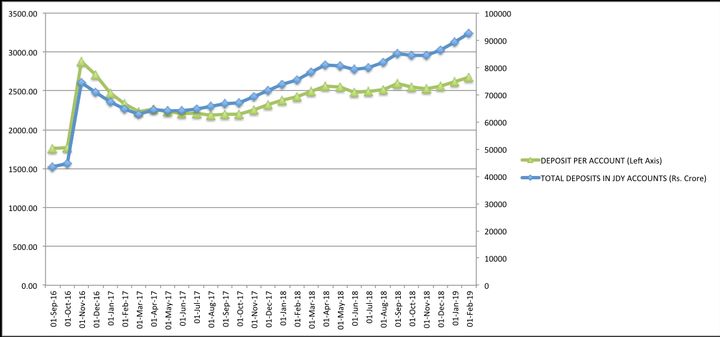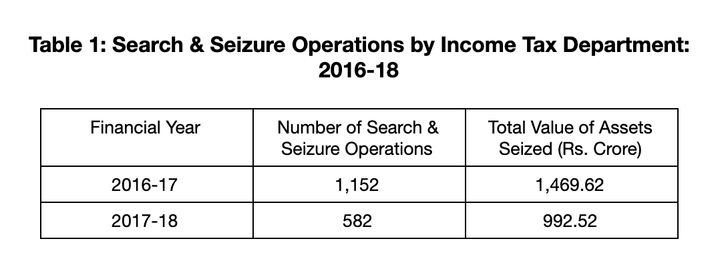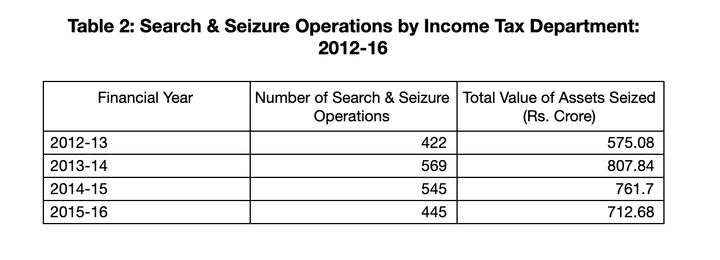
Earlier this week, an RTI reply revealed that Reserve Bank of India (RBI) board members were not convinced that demonetisation would be an effective step to curb black money in India. Disregarding these doubts, the Narendra Modi-led government went ahead with the move anyway. Not just that, over the past two years, the finance ministry has made repeated claims regarding the progress made in retrieving black money through ‘Operation Clean Money’, launched two months after the note ban announcement.
This author had submitted queries under the RTI Act, regarding the recovery of unaccounted wealth/black money, to the Directorate of Income Tax. In its response, the directorate provided the number of two kinds of PANs (Permanent Account Numbers): those that were identified for “online verification” of cash deposits since their “tax profiles were found to be inconsistent with the cash deposits made during the demonetization period” and those which were sent notices for not filing income-tax returns for the assessment year 2017-18.
However, the IT department was unable to state the amount of unaccounted money recovered from the bank accounts after such scrutiny. “As on date, various proceedings initiated under relevant sections of the Income-Tax Act in such cases are pending… details/statistics of unexplained cash detected and… amounts recovered… are not available…,” it said in response to the RTI.
This response proves that the Union finance ministry’s consistent claims about a successful crackdown on black money are baseless. A closer reading of the response along with other information available in the public domain establish three key points about the government’s ill-thought-out demonetisation gambit:
- Two years since its launch, no black money has been recovered under ‘Operation Clean Money’.
- Despite prima facie evidence of post-demonetisation money laundering through the Pradhan Mantri Jan-Dhan Yojana (PMJDY) accounts, the income-tax department has not taken any effective action in this regard.
- The increase in the recovery of illicit wealth/assets through the conventional IT raids after demonetisation is too small to justify a drastic step like scrapping 86% of the economy’s currency in circulation.

What did ‘Operation Clean Money’ achieve?
The finance ministry had launched this ‘operation’ in January 2017 after it became clear that almost all the proscribed currency notes would return to the banking system post-demonetisation. RBI had reported on 30 August 2017 that of the Rs 15.44 trillion worth of specified bank notes (SBNs) which were withdrawn on 8 November 2016, Rs 15.28 trillion (98.96%) had returned to the system by 30 June 2017. On the same day, the union finance ministry issued a statement titled ”Demonetization immensely beneficial to Indian Economy and People″, which had stated:
A significant portion of SBNs deposited could possibly be representing unexplained/black money. Accordingly, ‘Operation Clean Money’ was launched on 31st January 2017. Scrutiny of about 18 lakh accounts, prima facie, did not appear to be in line with their tax profile. These were identified and have been approached through email/sms. More than 9.27 lakh responses were received giving information on 13.33 lakh accounts involving cash deposits of around Rs.2.89 lakh crore. Advance data analytics tools were deployed which further identified 5.56 lakh new cases and about 1 lakh of those cases in which either partial or no response was received in the earlier phase.
This statement gave the impression of impending action against 6.56 lakh PAN holders in August 2017. Replying to starred question #19 in the Lok Sabha on 15 December 2017, finance minister Arun Jaitley had once again enumerated the following steps taken under ‘Operation Clean Money’.
- “17.73 lakh suspicious cases (no. of PANs) were identified involving Rs 3.68 lakh crore in 23.22 lakh bank accounts”
- “Responses sought online from 11.18 lakh people for 16.92 lakh bank accounts”
- Further, a total of 20,572 IT returns (ITRs) was selected for scrutiny under Computer Assisted Scrutiny System (CASS)-2017 in Cycle-2. Moreover, 1,16,262 notices under section 142(1) of the Income Tax Act are being issued to non-filers who deposited Rs 25 lakh or more in cash during demonetization but failed to file their return of income by the due date.”
According to the response to this author’s RTI queries, received on 28 February 2019, 23.48 lakh PANs were identified for online verification of cash deposits whose “tax profiles were found to be inconsistent with the cash deposits made during the demonetization period”. Out of this, 11.47 lakh PAN holders have submitted responses till 15 February 2019.
Further, notices under section 142(1) of the Income Tax Act were sent to 3.04 lakh PAN holders “where no income tax return was filed for AY 2017-18”. Out of this, 2.3 lakh PAN holders have filed e-returns.
However, the IT department has been unable to state the amount of unaccounted money recovered from such bank accounts or PAN holders after such scrutiny. In its response, the IT department says that “as on date, various proceedings initiated under relevant sections of the Income-Tax Act in such cases are pending...details/statistics of unexplained cash detected and...amounts recovered… are not available...”
What seems to have changed between August and December 2017 and February 2019 are the number of PAN holders/accounts under scrutiny and the number of notices being sent and responses received. In terms of actual recovery of black money, the IT department has no concrete results to show.
Jan Dhan Yojana deposits
In response to a specific query on whether notices were sent to any PMJDY account holder after December 2016, the IT department stated in its RTI response: “There is no flag received in the accounts reported to ITD which identifies with PMJDY.”
This is striking since the surge in the volume of deposits in the PMJDY accounts post-demonetisation had prompted the RBI to impose restrictions on withdrawals from such accounts on 29 November 2016. The RBI had stated:
With a view to protect the innocent farmers and rural account holders of PMJDY from activities of money launders and legal consequences under the Benami Property Transaction & Money Laundering laws, it has been decided to place certain limits, as a matter of precaution, on the operations in the PMJDY accounts funded through deposits of Specified Bank Notes (SBNs) after November 09, 2016.
Deposits in JDY accounts had shot up by over 40% in the first week after demonetisation with the outstanding amount increasing from Rs 45,636 crore (9 October 2016) to Rs 64,252 crore (16 October 2016) and further to Rs 74,609 crore by the first week of December (07 December 2016). By end-March 2017, the outstanding amount fell sharply to Rs 62,972 crore (29 March 2017).

A Business Standard report published on 05 September 2018 stated that documents reviewed by it suggested cash totalling Rs 42,200 crore being deposited in 3.74 crore JDY accounts between 8 November 2016 and 30 December 2016. Suggesting that about 60% of the money was part of suspicious transactions, the report had quoted Finance Secretary Hasmukh Adhia as saying: “Prime facie, these deposits cannot be said to be illicit. The information has been received by the CBDT for necessary investigations and consequential actions...In cases where the deposits do not match the profile, necessary investigations are done, the response of the depositor is taken and assessment is finalised on the basis of the evidence gathered”.
The response from the IT department to the RTI query on JDY accounts contradicts the claim made by the Union Finance Secretary that such accounts were under investigation by the CBDT. It now appears that despite the knowledge of large-scale money-laundering through the JDY deposits, the Modi government has simply let it go.
Income Tax Raids
In response to the RTI query on recovery of unaccounted money, the IT department has mentioned actions like ‘survey and search operations’ without providing any statistics for the same. Such data is available elsewhere. The Union Finance Ministry had stated in its statement on 30.08.2017:
The Income Tax Department (ITD) conducted searches on various entities, leading to seizure of cash and admission of undisclosed income. Since November 2016 and until the end of May 2017, a total of Rs. 17,526 crore has been found as undisclosed income and Rs. 1,003 Crore has been seized.
In response to the starred question #19 in the Lok Sabha on 15.12.2017, the Finance Minister had provided the following figures;
- The Income Tax Department conducted searches in 900 groups during November 2016 to March 2017 leading to seizure of assets of Rs 900 crore, including cash of Rs. 636 crore, and admission of undisclosed income of Rs. 7961 crores
- During the same period, 8,239 surveys were conducted leading to detection of undisclosed income of Rs. 6745 crore
In response to unstarred question # 2838 in the Lok Sabha on 28.12.2018 the Minister of State for Finance provided the following data on search and seizure operations by the IT department.

Search and seizure operations data from the previous years was provided in the affidavit filed by the central government in the Supreme Court in response to the petitions challenging the demonetisation decision in November 2016.

Once again, we find the Finance Ministry quoting different data at different points in time, which questions the credibility of the estimates. Going by the annual data on IT raids, the seizure of unaccounted wealth/assets rose from Rs. 1,437 crore in the two years before the demonetisation year (2014-16) to Rs 2,461 crore in 2016-18. This can hardly be considered as a significant increase, given the extent of black money that was estimated by official sources.
Moreover, this recovery of black money through IT raids could have happened without the shock of demonetisation, which inflicted pain on the majority of the population. A government serious about cleaning up the economy would have laid emphasis on overhauling the functioning of the IT department and enhancing its capacity to detect and retrieve black money.